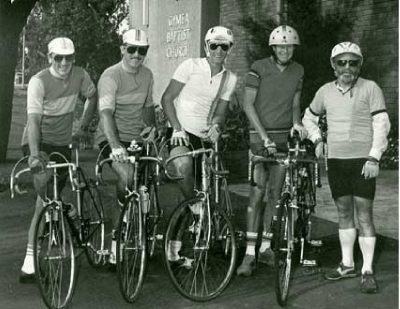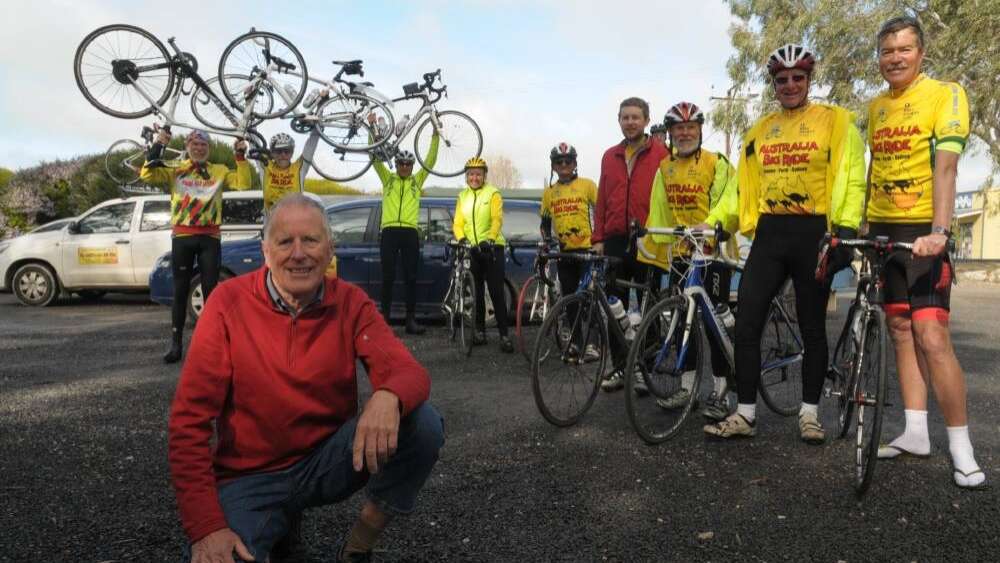Legends of Bike for Bibles honoured
The legendary Bike Man, Jim Blaxland, has been remembered as a humble and caring man who ensured the long-range Bike for Bibles rides he organised for Bible Society literacy programs ran like clockwork and everyone had fun.
Jim, who died on 31 January at the age of 79, was lauded at a memorial service in Sydney on 6 February as “an amazingly friendly bloke who loved God, people and organising crazily long fundraising bike rides,” in the words of Rick George, custom Bibles coordinator for Bible Society.
According to Les Moore, who rode with him on many occasions, Jim started riding regularly in 1985 to support a mate recovering from a broken leg and wanting to rebuild his muscles.
Raising funds to support literacy programs became a part of the fabric of their and their families’ regular lives.” – Les Moore
In 1987, while riding together in the Snowy Mountains, Jim suggested that they join a Bike for Bibles (BFB) team coming up from Tasmania to finish at Canberra. So they rode with the team on its last day, from Cooma to Canberra, a small beginning to what became a huge commitment over the next 35 years as Jim led and organised rides to and from every mainland capital and across the country.
“Through these rides, Jim influenced the lives and contributed to the Christian walk of hundreds of riders, roadies and congregations in many, many towns,” Les Moore writes in a tribute for Eternity.
“Jim’s first cross-Australia ride was Perth to Sydney in 2006 and he has ridden across the Nullarbor three times. He also led a Top-End ride from Townsville to Darwin to Broome as well. The longest ride he organised was in 2017, from Broome to Perth, Esperance and Sydney, a distance of 7231 km. He also led a top-to-bottom ride from Cairns to Melbourne in 2009, a distance of 3200 km.”
According to Les, the legendary part of Jim was his consummate sense of direction and memory of maps, terrain, towns and distances.
“He always knew exactly where he was, where he was going, and how to get there. His organising skills meant that everything was pre-planned and nothing was left to chance. Every ride went off like clockwork and many riders and roadies enjoyed his rides so much that they kept coming back year after year. Raising funds to support literacy programs became a part of the fabric of their and their families’ regular lives.
“Jim always ensured that the team did a nightly Devotional and also proclaimed Jesus through church presentations of the work of the Bible Society … Jim demonstrated through his actions that there was a way to glory for everyone and he showed them the way.”
“There was a set of ‘Jim’s rules’ to ensure everyone could enjoy themselves.” – John Gardiner
Another cyclist who was touched by Jim’s passion for riding, John Gardiner, also commented on his organisational prowess.
“Jim would organise these rides meticulously,” he said at the memorial service, which many attended wearing Bike for Bibles cycling shirts.
“As you rode with him leading up to these rides, he would tell you about his plans: what route he was considering; which towns we were going to; the church halls or the community halls or the school halls where we would be sleeping; what the changes were from the previous times we travelled in the same area; who he thought might be joining us as a ‘roadie’ to support the ride; how he was going to provide the food each day.
“Jim was a natural organiser. He didn’t want to leave anything to chance. He would drive the route beforehand to check the proposed facilities, check the distance between stops, to pick out the locations for morning tea and lunch each day. Mostly he would co-opt [his wife] Lyn to accompany him on these drives through the countryside. If he were a little unsure of the riding conditions on the road from these trips, he would also ride his bike over some sections, generally persuading Dave McCubbin or Les Moore to accompany him.”
John recalled that Jim would break up the riders into groups and nominate a person to be the road captain of each group. However, he never liked being in charge of a group – he preferred to ride at the back of his group.
“There was a set of ‘Jim’s rules’ to ensure everyone could enjoy themselves: No getting up before Jim’s alarm, no breakfast till everyone is packed up and bikes outside, fast team always cleaned the toilets,” John recalled.
“While we were on these rides, each evening, he would preview the next day’s ride, letting us know that morning tea would be at exactly 46.3km, lunch at 84.7 km; that we would be making a left hand turn at a T intersection at 19.6 km; and sometimes that there would be a few ‘uppish’ bits. Those on previous rides knew that this meant there would be a couple of big long hills to climb. He was always excited about a prospective ride, seeing the countryside and ensuring everyone would enjoy themselves. He was genuinely concerned with everyone’s wellbeing. You knew he just loved doing this.”
“These rides gave many the opportunity for adventures that otherwise were not available to them. To feel a sense of achievement and raising funds for very worthwhile activities. Since the rides were held during the school holidays, it enabled many of our school-aged children to attain an amazing sense of achievement to raise their self-esteem and to know that worthwhile things can be achieved with good planning and effort. My boys came along for several rides each. They tell me they were a very formative part of their upbringing.”
For his 60th birthday in 2003, Jim organised the first of his ‘big’ rides from Adelaide to Sydney.
“He gained great satisfaction from this ride, and it spurred him to undertake longer rides. I remember telling him that the more astonishing the proposed rides were, the easier it was to raise funds for charity.
“Perth to Sydney soon followed in 2006 with Cairns to Melbourne, Townsville to Broome via Darwin. Then his biggest ever ride in 2013 – Broome back to Sydney, about 7,000 km. Jim completed a lap of Australia on his bike doing these rides. The Townsville to Broome ride was the first that required camping on the side of the road and being much more self-sufficient as there are very few supermarkets or towns across the top. It was a significant step up, testing Jim’s organising ability as he had to do it more remotely than he had ever before. He couldn’t easily do a reconnaissance mission. It was a great ride with Jim almost always taking up his position at the back of the peloton.”
“Jim had all the churches working together often for the first time.” – John Gardiner
Over the years, John said Jim touched many people’s lives from churches, community groups and his mates.
“In some country towns where the church people provided us with dinner, Jim had all the churches working together often for the first time. He gave opportunities for others to lead, prepare and present devotions, to help with meals, and to thank community members for their hospitality.,” John said.
“If she can walk and ask people to give money for Bibles, why can’t I do the same whilst riding? I asked myself.” – Bob Forrest
Bike for Bibles, now an international program operated by Bible societies worldwide, was begun in Sydney in 1984 by Bob Forrest, who died in 2021, aged 89.

Bob Forrest, far left Back in 2010, he recalled how the venture came about.
“It began in 1984 when my son Dace and friend, Wayne McCamley, planned to ride their bicycles from Sydney to Melbourne. I was to act as their road support vehicle, carrying food, spares, etc. Still, after a 12-week training period (in which I participated), I decided I’d prefer to ride, so I recruited another driver and changed my position in the team.
“About this time, I was listening to the radio and heard of the determination of a young woman, Mary Hughes, who was walking 900 km from Sydney to Melbourne to fundraise for the Bible Society. Mary was making the trip to remind us of a young Welsh girl, Mary Jones, who made a similar trip in 1800 because of her deep desire to own a Bible.
“If she can walk and ask people to give money for Bibles, why can’t I do the same whilst riding? I asked myself.”
Bible Society heartily supported the idea and a tradition began to use the project to fund its literacy development programs.
The target of the initial BFB was just $2000 and Bob found it surprisingly easy to raise funds as he spread the word about the ride through his church family.
“I hadn’t ridden seriously for about 35 years, which meant really getting into training, but we had a great time together and it was a thrill to be able to give $2000 to the Lord’s work in Indonesia.”
Friends of Bob’s were soon begging to be part of the next adventure and in 1985, six riders raised $10,000 for Scripture portions for India.
In 1986, 42 cyclists, including a blind tandem rider, cycled 2700 km from Adelaide to Brisbane, raising $55,000 for literacy development in Guatemala.
After selling his car repair business, Bob joined Bible Society as a consultant for BFB. In 1987, 300 cyclists from all over Australia raised an incredible $350,000 for programs in Burma, Brazil and Kenya.
The following year was Australia’s Bicentenary when six Australians and eight international riders cycled 16,000 km around Australia, raising $500,000 to assist with literacy development for Indigenous Australians and Pacific Islanders.
The following years continued in this pattern, culminating in the Wheels Around the World event in 1996 when a team of 53 cycled 4600 km from Vancouver to Toronto, representing ten Bibles societies and raising $410,000 for Sudan and Ghana.
Many international riders who joined events in Australia have since run Bike for Bibles rides in their countries.
Email This Story
Why not send this to a friend?


